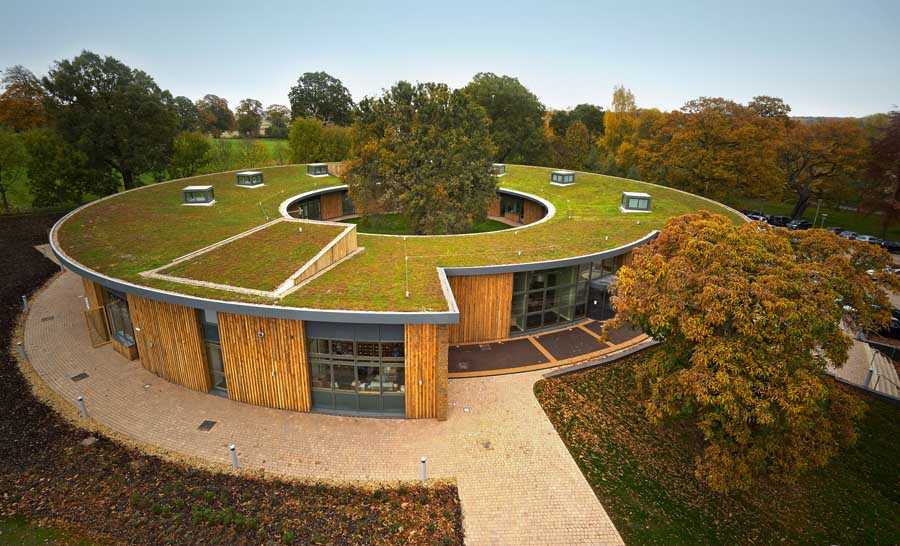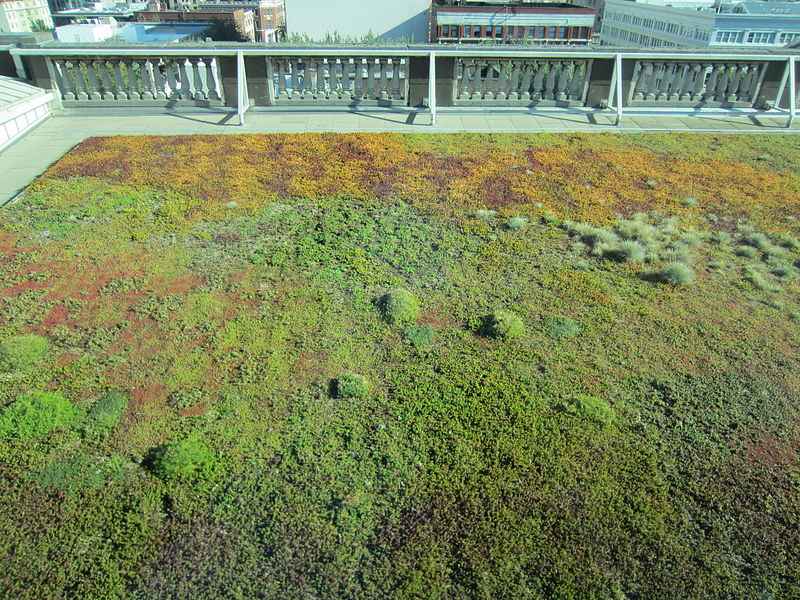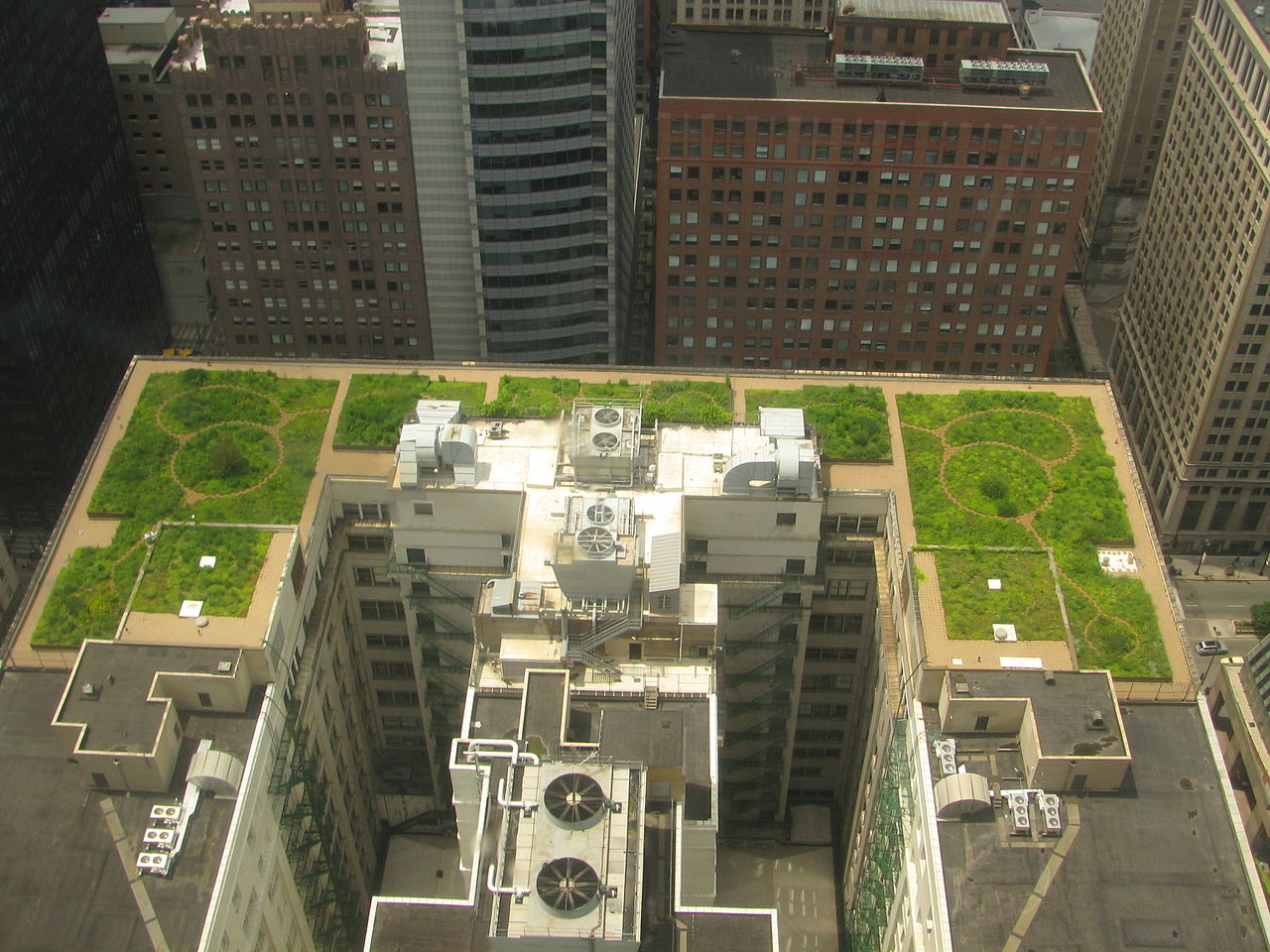Definition
Green roof belongs in the category of SUstainable Drainage Systems (SUDS) and aims at source controlling. A green roof or living roof is a roof of a building that is partially or completely covered with vegetation and a growing medium, planted over a waterproofing membrane. Primary objective is the reduction of storm-water runoff as part of a sustainable drainage system (Wikipedia, Greem roof, accessed on Sept. 2016).Co-benefits and impacts
Additional benefits gained by the use of green roof are the increase of roof lifespan, the reduction of energy use, climate change mitigation by decreasing the CO2 emissions derived by energy consumption, lessening of the urban heat island effect, increase of biodiversity, improvement of air and water quality and decrease of stress of the people around the roof by providing a more aesthetically pleasing landscape (Natural Resources Defense Council, 2012).Another, important advantage of green roofs in urban areas is the impact on the micro-climate as green roofs provide a cooling effect in the summer and do not freeze entirely in the winter. They also can enhance the evapotranspiration processes in urban areas. Intensive roofs provide a higher amenity or ecological value for the flora and fauna in urban areas as extensive green roofs. The quality of the rainwater runoff from the roofs can be improved as well, because mechanical and biological effects are provided by the infiltration through the soil layer on the roofs (Vojinovic Z., 2015).
Definition (GR)
Η πράσινη στέγη (φυτεμένο δώμα) ανήκει στην κατηγορία των Βιώσιμων Συστημάτων Αποστράγγισης και στοχεύει στον έλεγχο διαχείρισης των όμβριων υδάτων στην πηγή τους. Η πράσινη ή ζωντανή στέγη είναι μια στέγη κτιρίου, που καλύπτεται, μερικά ή ολικά, με βλάστηση κι ένα εδαφικό υλικό ανάπτυξης, και η οποία φυτεύεται πάνω σε μια αδιαπέρατη στο νερό μεμβράνη. Κύριος στόχος είναι η μείωση της απορροής των όμβριων υδάτων καταιγίδας ως μέρος του βιώσιμου συστήματος αποστράγγισης (Wikipedia, Greem roof, accessed on Sept. 2016).Co-benefits and impacts (GR)
Επιπρόσθετα οφέλη που αποκομίζονται από τη χρήση της πράσινης στέγης είναι η αύξηση της διάρκειας ζωής της, η μείωση της ενεργειακής κατανάλωσης, η άμβλυνση της κλιματικής αλλαγής μέσω της μείωσης των εκπομπών του διοξειδίου του άνθρακα (CO2) που προέρχονται από την κατανάλωση ενέργειας, ο περιορισμός της αστικής θερμικής νησίδας, η αύξηση της βιοποικιλότητας, η βελτίωση της ποιότητας του αέρα και του νερού και η μείωση του στρες των ανθρώπων γύρω από τη στέγη παρέχοντάς τους ένα πιο ευχάριστο, από αισθητικής άποψης, τοπίο (Natural Resources Defense Council, 2012).Ένα άλλο σημαντικό πλεονέκτημα των πράσινων στεγών σε αστικές περιοχές είναι η επίδραση που έχουν στο μικρο-κλίμα, καθώς οι πράσινες στέγες αυξάνουν τη δροσιά το καλοκαίρι και δεν παγώνουν τελείως το χειμώνα. Επίσης, ενισχύουν τις διαδικασίες εξατμισοδιαπνοής στις αστικές περιοχές. Οι στέγες εντατικής χρήσης διαθέτουν μεγαλύτερη ποικιλία ή οικολογική αξία για τη χλωρίδα και την πανίδα σε αστικές περιοχές σε σχέση με τις στέγες εκτατικής χρήσης. Η ποιότητα της απορροής των όμβριων υδάτων από τις στέγες μπορεί επίσης να βελτιωθεί, λόγω των μηχανικών και βιολογικών επιδράσεων που παρέχει η διήθηση του νερού μέσα στο στρώμα εδάφους (Vojinovic Z., 2015).
Flood management measure
The parent measure, in terms of this measure being a subcategory of the parent one
Case studies
Synonym of Flood management Measure
Last modified: March 4, 2020, 9:58 a.m.


 Ελληνικά
Ελληνικά


